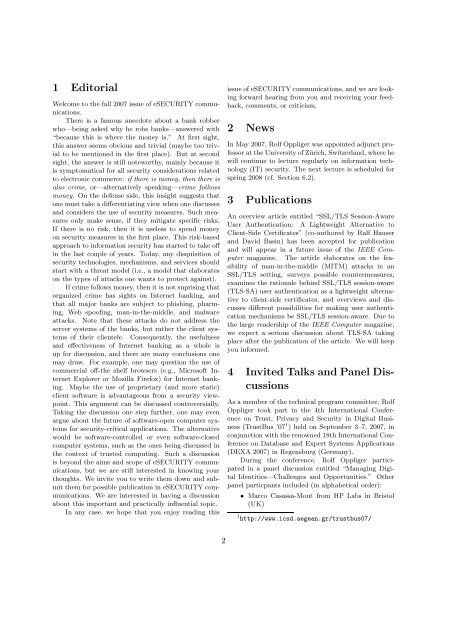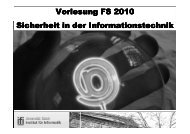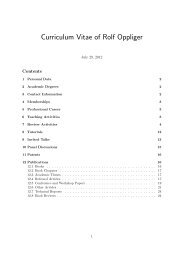communications - esecurity Technologies Rolf Oppliger
communications - esecurity Technologies Rolf Oppliger
communications - esecurity Technologies Rolf Oppliger
Create successful ePaper yourself
Turn your PDF publications into a flip-book with our unique Google optimized e-Paper software.
1 Editorial<br />
Welcome to the fall 2007 issue of eSECURITY <strong>communications</strong>.<br />
There is a famous anecdote about a bank robber<br />
who—being asked why he robs banks—answered with<br />
“because this is where the money is.” At first sight,<br />
this answer seems obvious and trivial (maybe too trivial<br />
to be mentioned in the first place). But at second<br />
sight, the answer is still noteworthy, mainly because it<br />
is symptomatical for all security considerations related<br />
to electronic commerce: if there is money, then there is<br />
also crime, or—alternatively speaking—crime follows<br />
money. On the defense side, this insight suggests that<br />
one must take a differentiating view when one discusses<br />
and considers the use of security measures. Such measures<br />
only make sense, if they mitigate specific risks.<br />
If there is no risk, then it is useless to spend money<br />
on security measures in the first place. This risk-based<br />
approach to information security has started to take off<br />
in the last couple of years. Today, any disquisition of<br />
security technologies, mechanisms, and services should<br />
start with a threat model (i.e., a model that elaborates<br />
on the types of attacks one wants to protect against).<br />
If crime follows money, then it is not suprising that<br />
organized crime has sights on Internet banking, and<br />
that all major banks are subject to phishing, pharming,<br />
Web spoofing, man-in-the-middle, and malware<br />
attacks. Note that these attacks do not address the<br />
server systems of the banks, but rather the client systems<br />
of their clientele. Consequently, the usefulness<br />
and effectiveness of Internet banking as a whole is<br />
up for discussion, and there are many conclusions one<br />
may draw. For example, one may question the use of<br />
commercial off-the shelf browsers (e.g., Microsoft Internet<br />
Explorer or Mozilla Firefox) for Internet banking.<br />
Maybe the use of proprietary (and more static)<br />
client software is advantageous from a security viewpoint.<br />
This argument can be discussed controversially.<br />
Taking the discussion one step further, one may even<br />
argue about the future of software-open computer systems<br />
for security-critical applications. The alternative<br />
would be software-controlled or even software-closed<br />
computer systems, such as the ones being discussed in<br />
the context of trusted computing. Such a discussion<br />
is beyond the aims and scope of eSECURITY <strong>communications</strong>,<br />
but we are still interested in knowing your<br />
thoughts. We invite you to write them down and submit<br />
them for possible publication in eSECURITY <strong>communications</strong>.<br />
We are interested in having a discussion<br />
about this important and practically influential topic.<br />
In any case, we hope that you enjoy reading this<br />
2<br />
issue of eSECURITY <strong>communications</strong>, and we are looking<br />
forward hearing from you and receiving your feedback,<br />
comments, or criticism.<br />
2 News<br />
In May 2007, <strong>Rolf</strong> <strong>Oppliger</strong> was appointed adjunct professor<br />
at the University of Zürich, Switzerland, where he<br />
will continue to lecture regularly on information technology<br />
(IT) security. The next lecture is scheduled for<br />
spring 2008 (cf. Section 6.2).<br />
3 Publications<br />
An overview article entitled “SSL/TLS Session-Aware<br />
User Authentication: A Lightweight Alternative to<br />
Client-Side Certificates” (co-authored by Ralf Hauser<br />
and David Basin) has been accepted for publication<br />
and will appear in a future issue of the IEEE Computer<br />
magazine. The article elaborates on the feasibility<br />
of man-in-the-middle (MITM) attacks in an<br />
SSL/TLS setting, surveys possible countermeasures,<br />
examines the rationale behind SSL/TLS session-aware<br />
(TLS-SA) user authentication as a lightweight alternative<br />
to client-side certificates, and overviews and discusses<br />
different possibilities for making user authentication<br />
mechanisms be SSL/TLS session-aware. Due to<br />
the large readership of the IEEE Computer magazine,<br />
we expect a serious discussion about TLS-SA taking<br />
place after the publication of the article. We will keep<br />
you informed.<br />
4 Invited Talks and Panel Discussions<br />
As a member of the technical program committee, <strong>Rolf</strong><br />
<strong>Oppliger</strong> took part in the 4th International Conference<br />
on Trust, Privacy and Security in Digital Business<br />
(TrustBus ’07 1 ) held on September 3–7, 2007, in<br />
conjunction with the renowned 18th International Conference<br />
on Database and Expert Systems Applications<br />
(DEXA 2007) in Regensburg (Germany).<br />
During the conference, <strong>Rolf</strong> <strong>Oppliger</strong> participated<br />
in a panel discussion entitled “Managing Digital<br />
Identities—Challenges and Opportunities.” Other<br />
panel particpants included (in alphabetical order):<br />
• Marco Casassa-Mont from HP Labs in Bristol<br />
(UK)<br />
1 http://www.icsd.aegean.gr/trustbus07/





